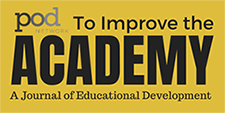Professional and Organizational Development Network in Higher Education

To Improve the Academy: A Journal of Educational Development
Date of this Version
2016
Document Type
Article
Citation
To Improve the Academy: A Journal of Educational Development (2016) 35(2)
Abstract
Two faculty developers at a professional art and design university were met with uneasy faculty attitudes toward grading when they opened their CTL 13 years ago. Conversations revealed that the faculty artists and designers suspected that grading would somehow shatter the fragile muse of creativity, which is so central to the processes of producing art and design. The developers’ quest for transparent, consistent grading, and assessment practices resulted in an approach to rubric creation that taps into artists’ reverence for the critique. This narrative account reveals how the approach allowed an interactive introduction of rubrics as teaching tools, ensured their use was rooted in the familiar pedagogy of art critique, and treated rubric assessment as an integral component of the teaching and learning process. The narrative culminates in the presentation of data that confirms the value of high quality rubrics to the teaching and learning of art and design, and it specifically confirms that such rubrics rarely squelch creativity. The approach and research can inform assessment—and teaching—practice for teaching artists or educators in other creativity driven fields.
Included in
Curriculum and Instruction Commons, Higher Education Commons, Higher Education Administration Commons, Higher Education and Teaching Commons, Other Education Commons


Comments
License: CC BY-NC-ND